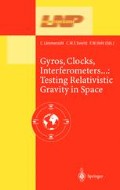Abstract
The main general relativistic effects in the motion of the Moon are briefly reviewed. The possibility of detection of the solar gravitomagnetic contributions to the mean motions of the lunar node and perigee is discussed.
Access this chapter
Tax calculation will be finalised at checkout
Purchases are for personal use only
Preview
Unable to display preview. Download preview PDF.
References
M.C. Gutzwiller: Rev. Mod. Phys. 70, 589 (1998).
J.O. Dickey et al.: Science 265, 482(1994).
K. Nordtvedt, these proceedings; Phys. Today 49, no. 5, 26 (1996).
B. Mashhoon and D.S. Theiss: Nuovo Cimento B 106, 545 (1991). A misprint in Eq. (64) of this paper should be corrected: The overall sign of the right-hand side of Eq. (64) should be negative. This correction would make that equation compatible with Eq. (8) of the present paper.
W. de Sitter: Mon. Not. Roy. Astron. Soc. 77, 155 (1916).
I.I. Shapiro, R.D. Reasenberg, J.F. Chandler and R.W. Babcock: Phys. Rev. Lett. 61, 2643 (1988). See also B. Bertotti, I. Ciufolini and P.L. Bender: Phys. Rev. Lett. 58, 1062(1987).
B. Mashhoon, H.J. Paik and C.M. Will: Phys. Rev. D 39, 2825 (1989).
C.A. Blockley and G.E. Stedman: Phys. Lett. A 147, 161 (1990).
B. Mashhoon and D.S. Theiss: Phys. Rev. Lett. 49, 1542(1982); Phys. Lett. A 115, 333 (1986); B. Mashhoon: Gen. Rel. Grav. 16, 311 (1984).
D.S. Theiss, Ph.D. thesis, University of Cologne (Köln, 1984); Phys. Lett. A 109, 19, 23 (1985); in Relativistic Gravity Research, edited by J. Ehlers and G. Schäfer (Springer, Berlin, 1992), p. 131; in Proc. First William Fairbank Meeting on Relativistic Gravitational Experiments in Space, edited by M. Demianski and C.W.F. Everitt (World Scientific, Singapore, 1993), p. 227; in Proc. Seventh Marcel Grossmann Meeting on General Relativity, edited by R.T. Jantzen and G. Mac Keiser (World Scientific, Singapore, 1996), p. 1555, p. 1558.
B. Mashhoon: Found. Phys. 15 (Bergmann Festschrift), 497 (1985). In this paper a misprint in Eq. (22) must be corrected: r0 in the denominator of the last term must be replaced by c. Furthermore, in Eqs. (11) and (13) the temporal components must be divided by c.
For the motion of the Earth about the Sun, α≈ 7°0, ∈ ≈ 10-8 and ξ ≈ 2 x 10-5 based on the standard value of solar angular momentum [cf. C.W. Allen, Astrophysical Quantities, 3rd ed. (Athlone, London, 1973)]. The Fermi frame adopted in this paper is such that the nutation vanishes at τ = 0. This frame can be obtained from the results given in Ref. [11]; see, especially, p. 506.
The precise definition of the notion of a local geocentric frame was formulated in [11] and further developed in S.M. Kopeikin: Celestial Mech. 44, 87 (1988) and V.A. Brumberg and S.M. Kopeikin: Nuovo Cimento B 103, 63 (1989).
It follows from a more complete treatment of the Newtonian problem that the mean motion of the lunar node can be characterized by a backward movement of frequency ω0N, which corresponds to a period of about 18.61 years. Similarly, the mean motion of the perigee can be characterized by a forward movement of frequency ω0P, which corresponds to a period of about 8.85 years. The theoretical expressions for N and P are rather complicated and depend on ω/Ω as well as the orbital eccentricities, etc. The first two terms of N and P in terms of ν =ω#x03A9;e given by \( N = 1 - 3v/8 - \cdot \cdot \cdot {\mathbf{ }}and{\mathbf{ }}P = 1 + 75v/8 + \cdot \cdot \cdot \) . A detailed discussion of this subtle problem is given by D. Brouwer and G.M. Clemence, Celestial Mechanics (Academic Press, New York, 1961), Ch.12, especially pp. 320–323.
Author information
Authors and Affiliations
Editor information
Editors and Affiliations
Rights and permissions
Copyright information
© 2001 Springer-Verlag Berlin Heidelberg
About this paper
Cite this paper
Mashhoon, B., Theiss, D.S. (2001). Relativistic Effects in the Motion of the Moon. In: Lämmerzahl, C., Everitt, C.W.F., Hehl, F.W. (eds) Gyros, Clocks, Interferometers...: Testing Relativistic Graviy in Space. Lecture Notes in Physics, vol 562. Springer, Berlin, Heidelberg. https://doi.org/10.1007/3-540-40988-2_15
Download citation
DOI: https://doi.org/10.1007/3-540-40988-2_15
Published:
Publisher Name: Springer, Berlin, Heidelberg
Print ISBN: 978-3-540-41236-6
Online ISBN: 978-3-540-40988-5
eBook Packages: Springer Book Archive

